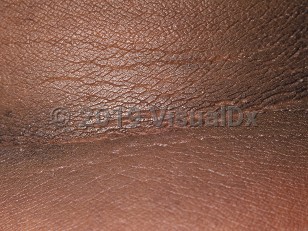Acanthosis nigricans in Child
See also in: AnogenitalAlerts and Notices
Important News & Links
Synopsis

AN is classified into 8 types:
I. Obesity-associated – Most common; linked to diabetes, insulin resistance, high body mass index (BMI), metabolic syndrome, etc.
II. Malignancy-associated / cutaneous paraneoplastic syndrome – Very rare in children, but has been documented with juvenile gastric adenocarcinoma (most common), Wilms tumor, and osteogenic sarcomas.
III. Drug-induced – Niacin (nicotinic acid) is the most closely associated medication, but AN can also be caused by oral contraceptives, corticosteroids, diethylstilbestrol, heroin, fusidic acid, methyltestosterone, protease inhibitors, and folate.
IV. Syndromic – Related to a specific syndrome, eg, HAIR-AN (hyperandrogenism, insulin resistance, and acanthosis nigricans) syndrome, polycystic ovarian syndrome, or autoimmune-disease, among others.
V. Acral – Affects elbows, knees, and knuckles. Typically seen in healthy sub-Saharan African patients.
VI. Unilateral – Also called nevoid. Usually represents an epidermal nevus in childhood.
VII. Benign – Rare autosomal dominant form developing at birth or during childhood. Typically stabilizes or regresses during puberty.
VIII. Mixed – Any 2 or more of the above types combined.
Codes
L83 – Acanthosis nigricans
SNOMEDCT:
402599005 – Acanthosis nigricans
Look For
Subscription Required
Diagnostic Pearls
Subscription Required
Differential Diagnosis & Pitfalls

Subscription Required
Best Tests
Subscription Required
Management Pearls
Subscription Required
Therapy
Subscription Required
Drug Reaction Data
Subscription Required
References
Subscription Required
 Patient Information for Acanthosis nigricans in Child
Patient Information for Acanthosis nigricans in Child- Improve treatment compliance
- Reduce after-hours questions
- Increase patient engagement and satisfaction
- Written in clear, easy-to-understand language. No confusing jargon.
- Available in English and Spanish
- Print out or email directly to your patient



